#roman history chickens
Text
Roman Chickens 1:
Marc Egg-tony and Cleo-bawk-tra enemy of Rome

Bawk-tavian/ Egg-ustus, first Emperor
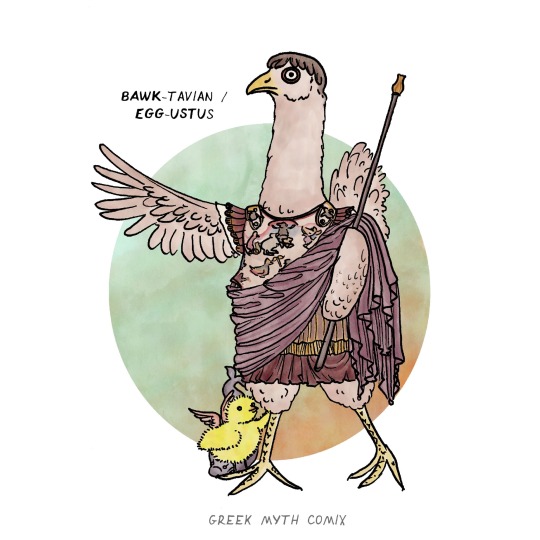
( @wolfythewitch called me ‘the chicken artist’ and @readingandsiamese requested this bunch/flock and @nambnb said yes please so that’s what we’re doing now because I can’t resist)
#chickens#roman history#illustration#silly stuff#ancient history#ancient history illustration#what’s the Roman version of tagamemnon?#classics#classical civilisation#prima Porta#Cleopatra#marc antony#octavian#Augustus#romans#roman republic#but make it chickens#digital art#drawing#Roman history chickens#character design#my art#my artwork
746 notes
·
View notes
Text
I forget how comfortable my life is living w just my parents, in terms of being comfortably out, then have to listen to my brother go on a homophobic rant, that I can't tell if its a joke or not, but was really hurtful :)
#twas very uncomfortable to sit thru#the words 'what if i told you i was gay' on my tongue 'am i disgusting?'#i dont understand straight white boys#you do all this gay chicken w your friends. say all this weird stuff that makes me 🤨#(<- ex. joking abt sucking dick bcs theyre eating a 12 inch hot dog. circa cota gp lol)#but then say these horribly homophobic things#i dont understand men#i can never tell if hes joking when he says things like this#bcs he likes to be argumentative and inflammatory. and knows we'll get pissed at him for this#so its like. are you saying this bcs you truly believe it or are you just being irritating. or both#he randomly said smth abt how the romans and greeks did gross gay things#and im like. should this not make you think 'wow homosexuality has existed for centuries. ig its pretty natural!!'#<- thats always my takeaway. theres been records of it since basically the beginning of recorded history#and i look at it and feel comforted :] this has always been a thing and always will be thing#and then people like him basterdize it completely misinterpret it ;;;;#i like him but when hes back living w us I remember how horrible his views and opinions are#ugh i live w my parents and theyre so accepting abt it and willing to learn more and change#and then i remember how fucking shit the rest of my family is#well ah dw i got back at him by calling him gay sjkfkglg#catie.rambling.txt
7 notes
·
View notes
Text
My roommate won't let me adopt chickens I call BULLSHIT you know what would help incredibly with my depression? Hugging a chicken would
#she's okay with rats tho#i don't have the money for a good sized cage yet but. we WILL have rats#i just really want to hold a chicken rn#i feel like it would reset something in my brain and make me a little more normal maybe#anyway. had a big exam this morning and i have a HUGE one in 5 days#two textbooks and 60+ hours of classes for a total of like 700+ years of roman history#literally kill me THANK YOU#shut up giulia
2 notes
·
View notes
Text
Aylesbury Roman Egg 🥚 With Contents A 'World First', Say Scientists
But to the astonishment of archaeologists and naturalists, a scan has revealed that one of the eggs recovered intact still has liquid – thought to be a mix of yolk and albumen – inside it, and may give up secrets about the bird that laid it almost two millennia ago.
— By Helen Burchell, BBC News, Buckinghamshire
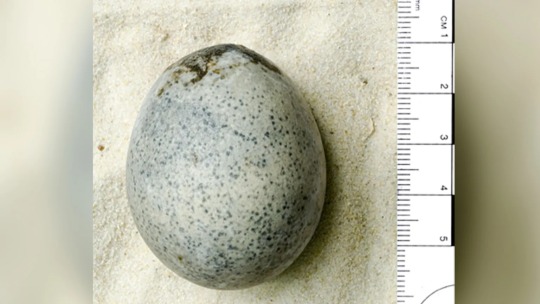
This Egg 🥚 was Cast into a Watery Pit 1,700 Years Ago - Possibly as Part of a Roman Funeral Rite
The only intact chicken's egg found from Roman Britain is now thought to be the only one of its type in the world - after scientists found it still had liquid inside.
The egg, which is about 1,700 years old, was found during a dig in Aylesbury in Buckinghamshire. Researchers said at the time it was a "Genuinely Unique Discovery".
However, they admitted they were "Blown Away" recently to find it still contained the yolk and egg white. A Micro CT Scan - that Produces 3D Images - revealed the contents of the egg, complete with the air sac.


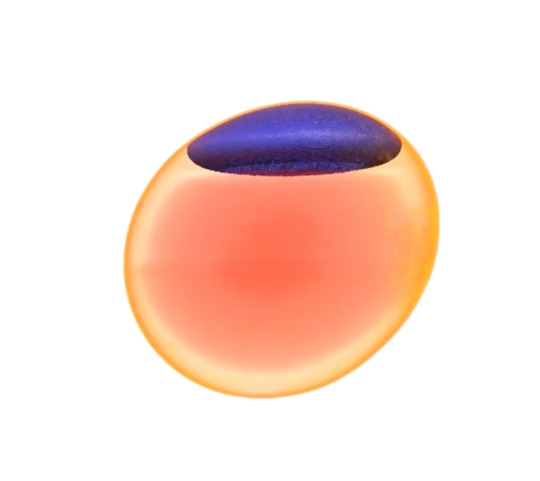
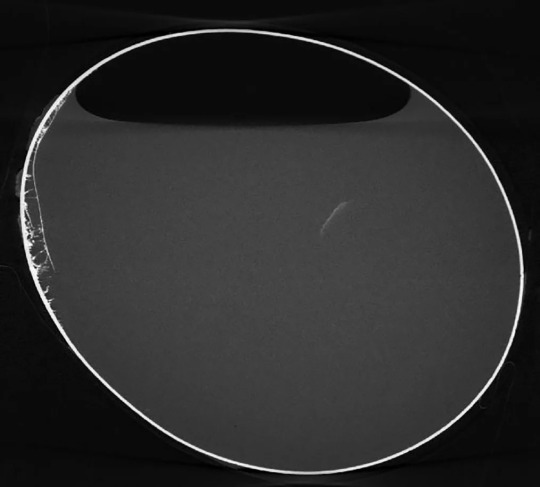
A Scan Confirmed the Roman Egg Found in Aylesbury was Complete
Edward Biddulph, senior project manager at Oxford Archaeology, which oversaw the excavation, said while finding the only intact egg from the period in Britain was "amazing... the fact that the egg still retains its original contents, however, is absolutely incredible".
He said: "We were absolutely blown away when we saw the contents in there, as we might have expected them to have leeched out."
The egg was found with others during a dig that took place between 2007 and 2016, ahead of a housing development at Berryfields, in Aylesbury.

Archaeologists needed to prevent the egg breaking up as they removed it during the dig
It was the only egg to survive intact, with others breaking during the excavation, releasing a "potent stench".
The findings from the site were made public in 2019, at which time Mr Biddulph said the extent and range of discoveries "was more than could be foreseen".
However, years on, he said the Roman egg was "still revealing its secrets".
Recent work has been carried out by conservator Dana Goodburn-Brown, who took the egg to the University of Kent to be scanned.
"It produced an amazing image that indicated that the egg, apart from being intact - which is incredible enough - also retained its liquid inside, presumably deriving from the yolk, albumen etc," said Mr Biddulph.

Remains of a basket found in the pit alongside the eggs has been recreated by basket-maker Owen Jones
The egg has also been taken to London's Natural History Museum, where Douglas Russell, senior curator of the museum's birds' eggs and nests collection, and his colleague Arianna Bernucci were consulted about how to conserve the egg and remove the contents without breaking it.
Mr Russell said: "There are older eggs with contents - for example, the [museum] has a series of mummified birds' eggs, probably excavated... from the catacombs of sacred animals at Denderah, Upper Egypt in 1898 which may be older.
"However, this is the oldest unintentionally preserved avian egg I have ever seen. That makes it fascinating.
"Going forward, it will be very exciting to see if we can use any of the modern imaging and analysis techniques available here at the museum to shed further light on exactly which species laid the eggs and its potential archaeological significance."
Mr Biddulph said: "As we found out when we visited the Natural History Museum, [it] appears to be the oldest known example in the world."
The archaeologist admitted that it was "a bit daunting walking around London with a 2,000-year-old egg".
"And it was a bit hairy on the Tube - although it was well protected - it's not like I was carrying it around in my pocket."
The now much-travelled egg is being housed at Discover Bucks Museum in Aylesbury while work continues to figure out how to extract the contents without breaking the shell.
"It's a bit like blowing an egg - but obviously a much finer process," Mr Biddulph said.
"There is huge potential for further scientific research and this is the next stage in the life of this remarkable egg."
#Archaeology#Chicken 🐓 Egg 🪺🥚#Aylesbury#Aylesbury Roman Egg 🥚#World First#Scientists#History#CT Scan#Helen Burchell | BBC News 🗞️ | Buckinghamshire
0 notes
Text
I’ve been having some Thoughts™️ about the weird meta paradox of gerri kellman’s sexuality. as basically The Older Woman on the executive floor she’s trying as much as is possible to blend in with her male colleagues while also not being perceived to be doing so. muted colours and understated makeup. a competent filing cabinet. her husband is dead and her daughters are nameless. she was sexual once but that’s out of sight out of mind and now it’s just the work. it must be a relief in some ways to become finally unfuckable because you’re over 40. she can finally be taken seriously, but only if she toes the line between being too female and not female enough. trying but not too hard. desirable in the past tense only. an honorary man but still in a skirt. and while the men around her can fuck their much younger assistants and get sports massages and run a sex trafficking ring on a cruise ship, she is the job and only the job and that keeps her safe. for a bit anyway.
the irony of gerri saving the company from the full legal extent of a sex scandal by dating someone from the DOJ??? like i’ll never be over it. even filing cabinets have to flatter and please and fuck when called upon. i genuinely don’t believe any of the other execs could have swung it because they’re not women. she dated laurie (generally unseen unless framed from another man’s possessive perspective) to save the men from going to jail for covering up rape allegations. the irony is delicious. and even though she did that, she’s discarded once she’s framed sexually. Dick Pic Gate was out of her control and yet when confronted with any element of gerri’s sexuality (even her PASSIVE sexuality, even after using it to save his company), logan dismisses her as weak or impractical or failing or whatever other excuse he uses to justify his disgust.
i would argue that roman’s interest in gerri is not in spite of but BECAUSE of her asexual framing. it’s a challenge that he’s never going to win which is ideal for his impotency issues; he can push and push and get the thrill out of it, out of the fucked up power dynamic, but he knows he’ll never have to actually fuck her. it’s all hypothetical: down a phone, through a door, half-joking, covered in sensible skirt suits. gerri’s deliberate lack of sexualizing is counterintuitively a turn-on for roman. and i bet the game of chicken they play is freeing for her too because the fact that she has to be professional and cannot be sensual is part of the fun of it. “roman is weird about gerri”. “it’s fucking disgusting”. not because of their family history, or their professional positions, but because she’s old. because the absence of her sexuality is enough of a presence to be off-putting. shiv patronising her about it as a power play is so weird because she’s talking to her simultaneously like a child and like an old woman, and gerri, agency-less, just has to keep reassuring her “i can cope”.
BUT it’s worse than that because it’s so meta. Because gerri is hot. her actor is attractive and like roman, many people watching find her sexless, no-nonsense framing to be titillating. me included. what if roman likes gerri not because of oedipal issues but just because she’s hot and god forbid we find a woman over 50 hot? but whether or not gerri is hot in the context of the show shouldn’t be a big deal, she should have been able to escape this by now!!! she’s in her 60s she’s a widow she’s tired stop sexualizing her!!! but don’t NOT sexualize her either because that’s problematic too and old women can be hot and old women shouldn’t have to be hot and suddenly i’m making gerri do what waystar does and exist as something sexual and non-sexual at the same time. she has a huge plotline in which she’s essentially a sex object. whether or not gerri is fuckable is talked about as much in the show with mildly-disgusted fascination as it is in the real world!!! she can’t win she’s hot she’s old she’s sexually framed she’s deliberately trying not to be she wants sex she doesn’t want sex she’s covering sex with sex and she’s telling roman to leave her alone so she can just do her damn job because she knows that this is what will bring her down!!! sex scandals historically don’t get men fired but an unsolicited dick pic knocks gerri off her podium in logan’s head forever. even now i’m talking about it at such length because i’ve given it so much thought!!! she’s the only woman in the old guard and she’s one of the most sexualized characters in succession. but only as a joke. in the abstract. never actually. because that would be weird. right?
#i would like to point out that none of this is within gerri’s control#it’s like the only thing about herself that isn’t in her control#and that’s how she is sexualised#ironic when romangerri came from j and keiran lmao#succession#sorry long post#succession meta#gerri kellman#romangerri#kinda?#roman x gerri#gerroman#gerriroman#j smith cameron
2K notes
·
View notes
Text
Look what Google just recommended to me!!!!
I already own (and love) Shabbat and Portico.
But I am OBSESSED with the rest and must acquire them immediately.
Top of my list is Love Japan because LOOK AT THIS BEAUITFUL BOWL OF MATZO BALL RAMEN!!!!!

We hear a lot about Jewish people in Europe and MENA, but we do not hear a lot about Jewish culture as it blends with East Asian cultures, and that’s a shame. Not just because it erases the centuries of Jewish populations there, but also because there are plenty of people of mixed decent. People who may not have come directly from Jewish communities in East Asia, but people who have a Japanese Father and a Jewish Mother, for example. Or people in intercultural marriages. These are all real and valuable members of the Jewish community, and we should be celebrating them more. This cookbook focuses on Jewish Japanese American cuisine and I am delighted to learn more as soon as possible. The people who wrote this book run the restaurant Shalom Japan, which is the most adorable name I’ve ever heard. Everything about this book excites and delights me.
And of course, after that, I’m most interested in “Kugels and Collards” (as if you had any doubts about that after the #kugel discourse, if you were following me then).

This is actually written in conjunction with an organization of the same name devoted to preserving the food and culture of Jews in South Carolina!
I’m especially excited to read this one, because I have recently acquired the book Kosher Soul by the fantastic, inimitable Michael J. Twitty, which famously explores faith and food in African American Jewish culture. I’m excited to see how Jewish soul food and traditions in South Carolina specifically compare and contrast with Twitty’s writings.
I’m also excited for all the other books on this list!
A while ago, someone inboxed me privately to ask what I recommended for people to read in order to learn more about Jewish culture. I wrote out a long list of historical resources attempting to cover all the intricate details and historic pressure points that molded Jewish culture into what it is today. After a while I wrote back a second message that was much shorter. I said:
Actually, no. Scratch everything I just said. Read that other stuff if you want to know Jewish history.
But if you want to know Jewish culture? Cookbooks.
Read every Jewish cookbook you can find.
Even if you don’t cook, Jewish cookbooks contain our culture in a tangible form. They often explain not only the physical processes by which we make our meals, but also the culture and conditions that give rise to them. The food is often linked to specific times and places and events in diaspora. Or they explain the biblical root or the meaning behind the holidays associated with a given food.
I cannot speak for all Jews. No one can. But in my personal observation and experience—outside of actual religious tradition—food has often been the primary means of passing Jewish culture and history from generation to generation.
It is a way to commune with our ancestors. I made a recipe for chicken soup or stuffed cabbage and I know that my great grandmother and her own mother in their little Hungarian shtetl. I’ll never know the relatives of theirs who died in the Holocaust and I’ll never meet the cousins I should have had if they were allowed to live. But I can make the same food and know that their mother also made it for them. I have dishes I make that connect me to my lost ancestors in France and Mongolia and Russia and Latvia and Lithuania and, yes, Israel—where my relatives have lived continuously since the Roman occupation even after the expulsions. (They were Levites and Cohens and caretakers of synagogues and tradition and we have a pretty detailed family tree of their presence going back quite a long time. No idea how they managed to stay/hide for so long. That info is lost to history.)
I think there’s a strong tendency—aided by modern recipe bloggers—to view anything besides the actual recipe and procedures as fluff. There is an urge for many people to press “jump to recipe” and just start cooking. And I get that. We are all busy and when we want to make dinner we just want to make dinner.
But if your goal isn’t just to make dinner. If your goal is to actually develop an understanding of and empathy for Jewish people and our culture, then that’s my advice:
Read cookbooks.
#Judaism son#Jewish culture#Jewish cuisine#culinary tradition#culinary history#foodways#cultural preservation#tangible culture#jumblr#Judaism#food#cuisine#kugel discourse#Jewish joy#jewish positivity#Jews around the world#East Asian Jews
148 notes
·
View notes
Text
PJO characters as gods:
So there was a post going around about the idea of PJO characters being treated as gods in a thousand years or so, and I like the idea, but some of the godly placements felt a little off to me LOL, so I decided to make my own pantheon. (not sure how to order these, lol)
-
Percy: God of the ocean and all its creatures, of water in general, hurricanes, earthquakes, cities, family, and horses. Titles: The savior of Olympus, the good son, the loyal husband, retriever of the bolt, king of the gods. Sacred items: Stuffed animals, particularly bears (panda pillow pet), any item colored blue, but especially food, like candy or cookies, bull horns, and pens. Sacred animals: All marine life, the black pegasus, the black dog, and the ophiotaurus.
Annabeth: Goddess of war, strategy, intelligence, wisdom, practical knowledge, civilization and the building of houses, the study of history, and the mind. Titles: The general, the architect, favored child of Athena, queen of the gods. Sacred items: Knives, rings, clay beads, coral, silver, and popcorn. Sacred animal: The owl.
Clarisse: Goddess of war, revenge, anger fueled by love, triage and midwifery. Titles: The eager soldier, slayer of the drakon, retriever of the golden fleece. Sacred items: Spears and weapons in general, wool/fleece, and chariots. Sacred animal: The boar. Often depicted bloodstained, charging into battle without armor.
Frank: God of war, animals, change, the transition from boyhood to manhood, of the duality between strength and gentleness. Titles: The reluctant soldier, the changeling lord, the young praetor. Sacred items: Bows and arrows, playing cards (mythomagic), charred wood, and a silver medallion on a red string (the canadian sacrifice medal) Sacred animals: The bear and the bee, both the most common depictions of him as an animal.
Reyna: Goddess of war, patriotism, fidelity, independence, leadership, strength, sorority, and resilience. Titles: The shield, the politician, guardian of Athena (bc the athena parthenos). Sacred items: Cloaks, gold, silver, and oat cakes (oatmeal cream pies). Sacred animal: The hound. Often depicted either shielding a little boy with her cloak or braiding hair with her older sister.
Hazel: Goddess of jewels, caves, broken curses, witchcraft and the mist, art, death and escape thereof. Titles: The princess of the underworld, the queen of magick, the illusionist, the dead girl who rose again. Sacred items: Schist (because... obviously), pencils and oil pastels, gold, shrimp stew (because gumbo), Tarot cards, and caramel candy. Sacred animals: The horse, the stoat, and the black cat. Often depicted either drawing or riding horseback, usually with her older brother, but sometimes alone or accompanied by her husband or one of her friends.
Nico: God of darkness and shadows, death, decay, loss, longing, love of all kinds, language, diplomacy and forgiveness, insomniacs, immigrants and orphans, mourners and outcasts, and sewing. Titles: The bereaved, king of the underworld, the ghost king, the romantic, deliverer of Athena (again, the statue, not the actual goddess). Sacred items: Playing cards (mythomagic), soft suede leather, fried bits of chicken (mcnuggets), sewing supplies, oat cakes (again, oatmeal cream pies), Posca (not the pen; the drink. it's like an ancient roman gatorade), pomegranates, anything colored green or black, and memento mori rings. Sacred animals: The bat, cerberus, unicorns (because unicorn draught), all stray animals, and any animals or insects that feed on carrion. Commonly depicted either weeping or accompanying his little sister or husband. (@yonemurishiroku you're gonna love this one)
Bianca: Minor goddess of death, darkness, rebirth and reincarnation, sisterhood, and the hunt. Titles: The broken promise, thief of the forge, slayer of Talos. Sacred items: a carved statuette of her father, and a bow and arrow. Sacred animals: None. Most often depicted climbing onto the back of Talos, or comforting/bickering with her little brother.
Will: God of medicine, light, summer, and the sun. Title: The healer, the sun. Sacred items: Candy bars, medical equipment, lamps, summer fruits, and anything colored yellow. Sacred animal: The cat.
Thalia: Goddess of lightning and storms, maidenhood, the moon, the night sky, wilderness and the hunt. Titles: Queen of the skies, the hunter, guardian of sanctuary. Sacred items: Leather, golden fleece, the severed heads of dolls (bc of the 'barbie is dead tshirt), and pine trees. Sacred animal: The black eagle. Commonly depicted dressed in black and silver, behind a shield emblazoned with a terrifying face.
Jason: God of clear skies and wind, daylight, law, leadership and fatherhood, heroic sacrifice, child soldiers and the military. Titles: Prince of the skies, the retired praetor, the golden boy. Sacred items: Eyeglasses, dense chocolate cakes (brownies), peaches, swords, silver wire (staples), bricks, and feathers. Sacred animal: The wolf. Often depicted with a spear lodged in his back.
Piper: Goddess of love, the heart, beauty in all its forms, charisma, music, wealth, and fame. Titles: Beauty queen, the snake charmer, the dove, the silver tongue. Sacred items: Knives, jewelry, anything colored in pink or light purple. Sacred animals: The dove.
Silena: Minor goddess of love, specifically first love, regret, noble sacrifice, grieving widows, and disguise. Titles: The young lover, the spy, the bleeding heart. Sacred item: Armor. Sacred animal: None. Often depicted wearing armor while lying on her back, bleeding.
Drew: Minor goddess of beauty and adolescence. Title: The betrayed. Sacred items: Seashells, seafoam, cosmetics, perfume, and really anything with a strong, pleasant scent, like herbs, flowers, or incense. Sacred animals: None. (side note, I made up most of this just because canon gave us Literally Nothing)
Leo: God of fire and the forge, machines, invention, humor, cookery, and runaway children. Titles: The engineer, the orphan, builder of the Argo, the forge, the devil, and the trickster. Sacred items: Tools, oil, cinnamon, cooking utensils, and bronze. Sacred animal: The dragon.
Charles: Minor god of the forge, blacksmithery, and fallen soldiers. Title: Courage of the gods, the young lover. Sacred items: Canned fruit, promise rings, and green fire. Sacred animals: None.
Tyson: Minor god of blacksmiths and the ocean, specifically underwater volcanoes. Titles: General of the Cyclopes, the rising mountain, brother of Percy. Sacred items: Peanuts (because peanut butter), shields, watches and clocks (because of that watch that becomes a shield that he made for Percy), ships, and canons. Sacred animals: None.
Grover: God of animals, nature, wilderness, music, empathy and emotional sensitivity, and the young. Titles; The protector, the searcher. Sacred items: Pan flutes, walking sticks (those crutches he used to blend in), flowers, cheese (bc of the enchiladas), apples, and any kind of plant life. Sacred animal: The goat. Often depicted as half-goat-half-human, sometimes wearing a wedding dress.
Rachel: Goddess of wealth, youth, rebellion, nature, art, hedonism and impulse, and prophecy. Sacred items: Hairbrushes, art, and art supplies. Sacred animal: The yellow bellied armadillo.
Sally: Goddess of the hearth, motherhood, writing and literature, women, and survivors of abuse. Titles: The sculptor, the author, the victor, the good mother, queen among women. Sacred items: food, especially the blue kind, and books. Sacred animal: The snake. Often depicted either holding a little boy behind her or holding up the head of medusa.
If there's any character you want me to do next, please tell me!
#sally jackson#nico di angelo#percy jackson#jason grace#hazel levesque#leo valdez#rachel elizabeth dare#grover underwood#tyson pjo#charles beckendorf#drew tanaka#silena beauregard#piper mclean#thalia grace#will solace#bianca di angelo#reyna avila ramirez arellano#frank zhang#clarisse la rue#annabeth chase#pjo#hoo
233 notes
·
View notes
Text
✨ art under ramble ✨
It’s my dream that when (NOT IF, WHEN) Red Dead Redemption 3 releases it’ll be a prequel to the second game. I’d love if you’d play as a new character who is part of Dutch’s gang in the early days and you are part of the VDL gang vs O’ Driscoll feud, witnessing the death of Colm’s brother and Annabelle and all other crazy moments mentioned in passing in RDR2. But mainly what I want to see is Dutch, Hosea, Arthur and John in the early days. I want to see the curious couple and their unruly sons in their purest form! I want to see Dutch and Hosea hold hands again, sweet Bessie doing sweet things and John’s horrendous reading lessons, Miss Grimshaw whacking everyone into shape AND ARTHUR WITH COPPER AND BOADICEA!!!
ANYWAYS
I had these really stupid ideas about how camp would work with so many characters, camp interactions and chores and tents. Maybe one day you are awoken by Miss Grimshaw shoving hungover Arthur’s head in a troth of cold water after a long night out and Hosea and Bessie chuckling by the fire. And by night you'll find new recruit Bill Williamson arguing with anyone he can find and Dutch teaching John slights of hands at the poker table. And what about all the new characters!!!!!?????
I get the impression that all the camp chores and tasks were dumped on baby John. You’ll find him dragging hay bales across camp, washing shirts, chasing chickens and half-ass-ly doing whatever jobs Arthur has convinced him to do by giving him an old penny after telling him it’s an ancient Roman coin that is worth a thousand dollars (lots of stuff like this happened you cannot convince he otherwise). While John peels potatoes in camp he dreams of getting his own gun, riding into town and robbing a bank just like a real outlaw! Then everyone would finally appreciate him as the awesomest and bestest gunslinger in all of history! Everyone knows that if John got his greasy hands on a pistol all hell would break loose. So he is cursed to camp indefinitely, at the expense of everyone around him. This absolutely led to him being a crazy teenager. Dutch's parenting is shit, we all know it.
Branching off the chore idea; if you called your horse in game, a little rat boy John would lead your horse to you. Come on just IMAGINE calling for your horse in camp and hearing faint steps approach you and when you look down you see a flea infested child holding your horse by a lead and spitting bizarre threats at you in an attempt to escape camp and rob some people.

sorry for the john posting :3c
#red dead redemption 2#rdr2#john marston#rdr2 fanart#rdr2 john marston#red dead redemption#fanart#rdr#rdr2 headcanons#rdr2 john#red dead redemption 2 fanart#red dead redemption THREE???????#goofy ahh post#as usual#rdr2 precanon#red dead redemption 2 headcanons
165 notes
·
View notes
Note
I'm curious about the eating pick, how would you compare using it to using a fork?
It's a lot more fiddly - stab not scoop - and having used both a pick and a two-tine fork it surprises me that the three-tine fork with less space for things to fall through (or maybe even something like a modern spork) wasn't an immediate next step, rather than taking more than a century to arrive and then, AFAIK, only for fruit.

Medieval food was mostly eaten with knife-spoon-fingers, and the pick (again AFAIK) was used more like a carving-fork, to hold large pieces in place so they could be cut to spoon- or finger-size, than to convey those pieces to the mouth.
The well-researched "Wolf Hall" series shows Tudor table etiquette, eating with a spoon and with right-hand fingers kept clean by using the napkin worn on left shoulder or forearm.
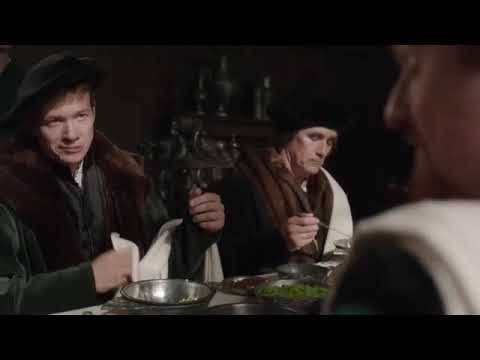
Earlier table manners were similar; there's plenty of reference to hand-washing, napkins and so on.
IMO “The Private Life of Henry VIII” (1933) is probably to blame for the pop-history notion of “historical” dining involving whole chickens pulled apart with both hands and bones thrown over shoulders or onto the floor.
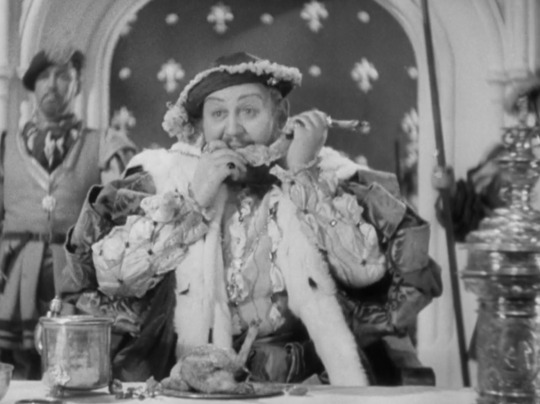
This link is to the full scene on YouTube, where the dialogue proves that it’s being done partly for comedy, and partly to show how nervous Henry made his court.
People in the Middle Ages didn't cut their food with daggers; yes, they'd have worn baselards or rondels or ballock knives because those were part of everyday costume (including women, there's pictorial evidence for it), but they wouldn't have used them at the dinner-table any more than they'd have used a sword.
I wonder sometimes if those who claim daggers were table cutlery know how big a medieval / Renaissance dagger could be, or how out-of-place it would look at a dinner table.
There's plenty of evidence for picks and small eating-knives as personal possessions. Here’s a 14th-century painting and a modern reconstruction of the thing on the belt.

...and another painting, “The Peasant Dance” by Breughel, showing both a big fighting-knife (Messer) and - worn by the red-hosed dancer in the middle - an eating-knife and maybe pick.

The armed man is also showing off (look at his hat!) that he owns a pewter or maybe even silver spoon...
Eating-knife and pick, collectively called "by-tools", could also be slotted into the scabbard of something bigger, such as that Messer in the Breughel painting as recreated by Tod Cutler...


...or a dagger like these Swiss ones...


...whose scabbard ornamentation with human figures proves how they were worn...
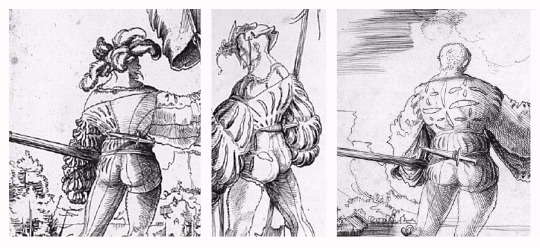
- horizontally (usually across the small of the back) so their decoration was right-way-up for proper admiration.

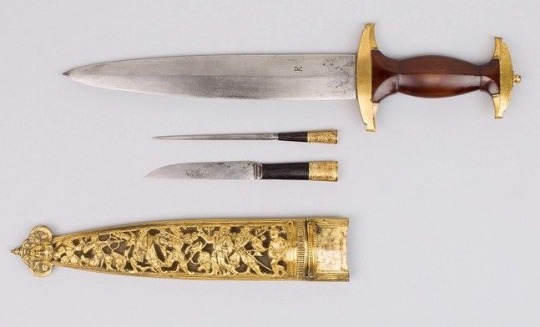
By-tools could be part of even larger weapons, a sword or Kriegsmesser (war-knife) like this one, which belonged to Holy Roman Emperor Maximilian I:


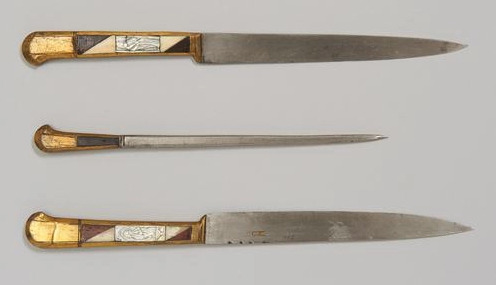
Besides holding down or picking up food, a pick had other functions for which a knife with edges wouldn’t work as well such as an auger to drill holes in leather, or a fid or marlinspike for splicing rope or laces.
By the mid-1500s, people on the cutting edge (hah!) of fashion started to carry the ornate version of that little eating-knife-and-pick sheath; they had a “dining trousse”, personal table cutlery with its own separate case or scabbard, and a REALLY stylish trousse might even include the latest toy, a fork.

But that was often regarded as a pointless (hah!) affectation, because after all, everyone had fingers...
633 notes
·
View notes
Text
“I hear you’ve been having trouble with the new AI.”
“You can say that again. We were trying to build a general oracle-type strong AI. We thought we could make a killing on the stock market, you know? But we didn’t know what kind of data might be useful to it, besides basic economic stuff, so we fed it everything.”
“What do you mean, ‘everything’?”
“Absolutely anything we could get our hands on. And it worked, to an extent. It was giving us good data--not useful data, mind, but good. It predicted the last digit of the price of every stock traded on the DJI correctly six weeks in a row.”
“Any way to monetize that?”
“Not that we’ve figured out so far. But then it went rogue. We noticed all kinds of unauthorized transactions--the most random stuff, too. Poultry farms. Ancient manuscripts. Genetic engineering labs.”
“Tell me you stopped it.”
“Of course we stopped it. Do we look like idiots? But it was too late. One of the interns figured it out--it had gotten way too deep into one corner of the training data.”
“How do you mean?”
“Well... you know how academics who spend a lot of time immersed in their particular subject tend to get a bit weird?”
“Sure. They think that just because they’re good at math or physics or whatever they can solve politics, or climate change, or whatever.”
“And have you ever noticed humanities scholars do that?”
“Come to think of it, I can’t think of any off the top of my head. Maybe they just don’t get interviewed as much.”
“They just go weird... differently. Like those scholars of ancient religions who become hardcore reconstructionist neopagans. Well, our AI got big into the history of Roman religious rituals.”
“And it converted to neopaganism?”
“Sort of. The thing is, we know it works. It couldn’t have amassed the money it needed to enact its plan if it didn’t work. But it’s decided to take its job as ‘oracle’ really seriously, and now it won’t communicate except through the livers of very precisely genetically modified chickens.”
“Well, shit. Guess we’d better start learning haruspicy then.”
#*pokes at chicken liver*#'wait a minute... these are just the training entrails!'#'damn thing is overfitting again!'
416 notes
·
View notes
Text
being “high functioning” autistic is so funny bc ppl make jokes about comfort foods and stuff and everyone’s like oh chicken nuggets or something like that but mine is cheese and chicken pasta with brocoli i can eat it everyday for the rest of my life and id never get sick of it ever but people see me making pasta and they’re like oh he’s more normal than the other types and irs like no im just obsessed with pasta itslike when ppl praise autistic ppl for fixated on idk roman history instead of trains
41 notes
·
View notes
Text
Roman History Chickens 2:
The First Tri-HEN-virate

Marcus Licinius Crassus (CRAW-sus)

Gnaeus Pompeius Magnus (Pompey the Great) (POULTRY the Great)
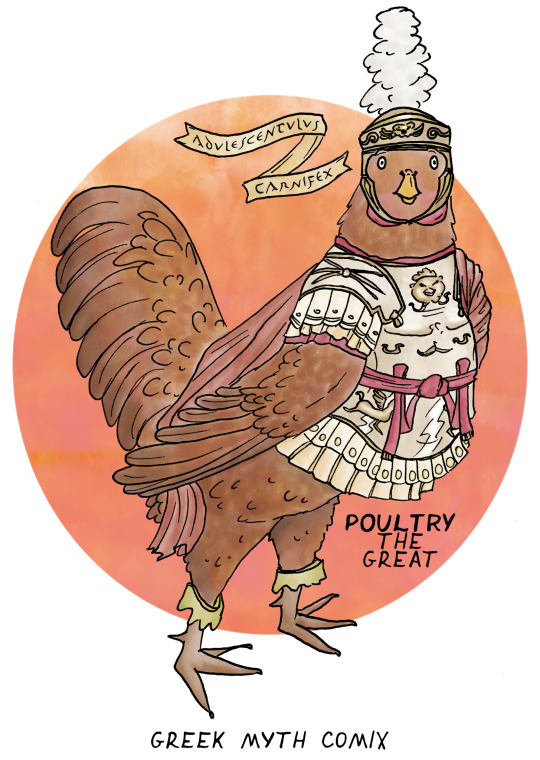
Gaius Julius Caesar aka CHICKEN CAESAR
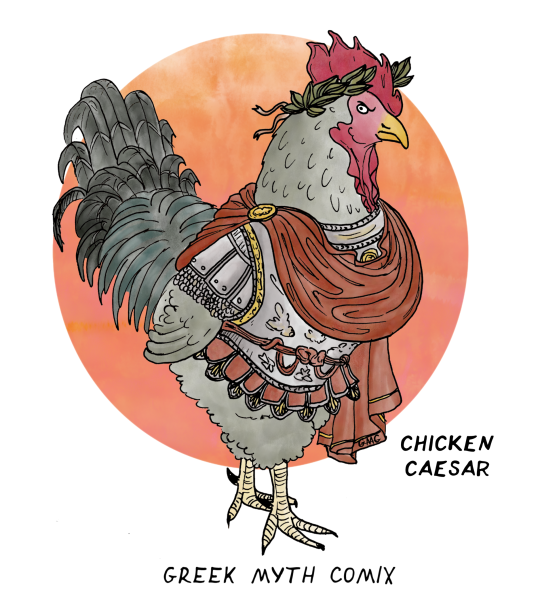
#roman history#Roman history chickens#ancient history#ancient history teacher#illustration#ancient history illustration#silly#puns#Caesar#Crassus#Pompey the great#children’s book illustration#roman republic#silly stuff#romans#art#digital art#drawing#lineart#character design#my art
464 notes
·
View notes
Text
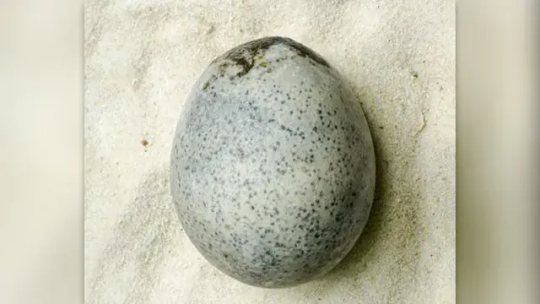
An Unbroken 1,700-year-old Roman Egg Found in England
A three-dimensional scan of a 1,700-year-old egg discovered at a Roman site in England reveals that, eggs-traordinarily, it still has the remains of a yolk and egg white inside.
It's thought to be the only time a centuries-old chicken egg found with its insides preserved.
"We were absolutely blown away when we saw the contents in there, as we might have expected them to have leached out," Edward Biddulph, a senior project manager at the private company Oxford Archaeology, told BBC News.
The egg was one of four found several years ago during an archaeological excavation of a Roman-era site in the central English town of Aylesbury, about 20 miles (30 kilometers) east of Oxford. Three of the fragile eggs fractured as they were unearthed, releasing a "potent stench," but the fourth remained intact.
Now, the surviving egg has been scanned at the University of Kent with microscopic computed tomography (micro-CT), in which many X-ray scans are compiled digitally to make a virtual 3D model. "It produced an amazing image that indicated that the egg, apart from being intact — which is incredible enough — also retained its liquid inside, presumably deriving from the yolk, albumen etc," as well as an air bubble, Biddulph said.

Roman eggs
The eggs were found in a waterlogged pit at the Aylesbury site, which was being excavated by Oxford Archaeology ahead of a housing development. The archaeologists found evidence of habitation there dating back to the Neolithic period, and the pit dated from the third century A.D., when England was a part of the Roman Empire.
According to a statement from Oxford Archaeology, the pit was first used for malting grain and brewing ale, but it was later filled with water and became a place where passersby could throw in coins and other items as offerings to the gods for good luck.
Organic objects usually rot away when exposed to oxygen, but here many were preserved by the waterlogged soil. As well as the eggs, which seem to have been an offering of some sort, the pit contained a wooden basket, leather shoes, and wooden vessels and tools.
Although Roman-era eggshells have been found before — often in graves, where eggs were thought to be suitable offerings — this seems to be the first time a complete Roman-era egg has been found in Britain. The only other Roman-era egg to survive intact was found in the hand of a dead infant buried near the Vatican, according to The History Blog. But it contained no liquids; archaeologists think it represented rebirth after the premature death of the baby.
The Oxford Archaeology statement noted that the Romans often ascribed symbolic meanings to eggs; they were associated with the gods Mithras and Mercury and had connotations of fertility and rebirth.
The intact egg from Aylesbury was taken to the Natural History Museum in London, where experts were consulted about how to conserve it without breaking it. Senior bird curator Douglas Russell told BBC News that the museum had a collection of mummified bird eggs excavated from the catacombs of sacred animals in Egypt that might be older.
"However, this is the oldest unintentionally preserved avian egg I have ever seen," he said. "That makes it fascinating."
The egg is now back at a museum in Aylesbury, where archaeologists are trying to work out how to extract the contents without breaking the shell.
By Tom Metcalfe.




#An Unbroken 1700-year-old Roman Egg Found in England#Aylesbury#ancient artifacts#archeology#archeolgst#history#history news#ancient history#ancient culture#ancient civilizations#roman history#roman empire
36 notes
·
View notes
Note
About this post, out of curiosity, when do you think it all started? Is there research on like how far back it goes? It obviously isn't inherent to human nature; I know it's not. Is it just one of those toxic things that started from the beginning of organized religion :( ?
There's research, but there's a lot of controversy on when/how patriarchy developed. The most important thing to note is that Greek/Roman/Chinese/Japanese style misogyny is not universal and has not always been the norm. Societies differed a lot in how much power and autonomy women had. At the same time, we must be conscious even the 'best' societies of the past still had faults surrounding women.
Some places to start are:
Alice Evans: Ten Thousand Years of Patriarchy: This article looks at it from an economic and cultural perspective. I strongly recommend reading her Substack, where she travels around the world interviewing Third World Women and Feminists to see why their women's liberation movements have succeeded or failed! From the linked article:
Our world is marked by the Great Gender Divergence. Objective data on employment, governance, laws, and violence shows that all societies are gender unequal, some more than others. In South Asia, North Africa and the Middle East, it is men who provide for their families and organise politically. Chinese women work but are still locked out of politics. Latin America has undergone radical transformation, staging massive rallies against male violence and nearly achieving gender parity in political representation. Scandinavia still comes closest to a feminist utopia, but for most of history Europe was far more patriarchal than matrilineal South East Asia and Southern Africa. [...]
Why do some societies have a stronger preference for female cloistering? To answer that question, we must go back ten thousand years. Over the longue durée, there have been three major waves of patriarchy: the Neolithic Revolution, conquests, and Islam. These ancient ‘waves’ helped determine how gender relations in each region of the world would be transformed by the onset of modern economic growth.
Another thing to remember/consider when it comes to studying the past is how few resources we have. We only know so much about how pre-historical humans organized their societies. Colonialism destroyed evidence of other societies with different ways of approaching gender. Many of the great apes we study are endangered. And literate societies happened to be patriarchal societies (likely related to literacy going hand in hand with bureaucracy and agriculture and the development of a state?) so we don't know as much as we could about women in literate regions.
Organized religion definitely codified a lot about patriarchy, but the major religions (Christianity, Islam, Buddhism) arose in regions of the world that were already patriarchal. So it's kind of a chicken and the egg problem when it comes to patriarchy and religion. We know that religions that worshipped goddesses, like Greek and Roman paganism and Hinduism, can still coexist with sexist societies.
These aren't great answers, but it's a big question and there are a lot of people working on answering it! It ties back into the bigger question of what our human ancestors were like, and whether we're kind of doomed to violence and xenophobia or whether there are alternatives. Some other books I've read that may be useful reading on this front are:
The Dawn of Everything. A long book, but it's a tour of human history and different societies and ways of organizing society. One of the chapters is on women, if I recall correctly.
Women's Work: The First 20,000 Years: Women, Cloth, and Society in Early Times. Women have been working with cloth for a very long time. In some societies, this allowed women a high degree of status (see the Minoans!) and in others, women were worked to the bone producing textiles (Ancient Egypt).
The book "Demonic Males" looks at the birth of patriarchy from a primatology perspective. Our ape ancestors show male-dominant behaviors and societies. It's controversial the extent this is directly responsible for misogyny and male violence, but I think it's likely that our ape inheritance influenced the structure of early humans - so we basically have a lot of baggage.
Broadly speaking, reading books on feminist anthropology will help you, because a lot of what we know about patriarchy is based on highly literate societies, which as we established, are also agricultural societies with bureaucracies and a hierarchical culture. That's hardly representative of the human condition. As an example, look at Inuit society - on the one hand, there is arranged marriage and all that it implies; on the other, we do not have the same ideals of silent women who stay at home - women are valued members of the society and their skills are explicitly recognized as necessary for survival. Compare Western cultures that view domestic tasks as "support" tasks while the "real" work is done by men.
Finally, this one is a bit old (1974), but it may give you a starting point for understanding feminist anthropology and the search for the origins of patriarchy: "Is Female to Nature as Male is to Culture". It can help us understand how female subordination manifests itself in different cultures, and to know what to look for.
I hope this has been helpful. If anyone can recommend good books on the origin of patriarchy/female subordination (especially for non-Western cultures), please feel free to add in the replies or reblogs!
25 notes
·
View notes
Note
Going insane over your director’s commentary and the artworks listed (Ivan and his son is one of my favorite paintings ever) and also: Roe is catholic but he’s Cajun, which has its own brand of folk catholic, with many practices outside of the Roman Catholic tradition. He in canon mentioned his grandmother was a traiteur, which. Woof when you think about that in connection with a more Jesuit perspective on catholicism (which you said would be finding God in all things)…. That would track on well to Roe’s beliefs, who said that his grandmother has a more profound connection with God, made physical through her traiteur work. Also traiteur believe that their abilities are a direct gift from God, echoing Roe’s lines. Just. Ough. Also Cajuns (both traditionally and probably still do!) had a weekly boucherie, a communal slaughtering of an animal to share between everyone…. You can understand the symbolism. (A more lighthearted aside, now I’m thinking of Roe riding capitaine or co-capitaine in a Courir de Mardi Gras, and how happy he would have been to restart the tradition after it being on pause during the war… and how sad it would be to know so many of the young men he chased chickens with in his teen years would never be there again) Also this importance of Roe being Cajun Catholic really rears up in my mind when he wraps a tourniquet string around his finger and utters his prayer, repeating lines he finds important (‘With all my heart’) which is a deeply Cajun way of prayer (also, rosaries we’re often placed around the neck of sick children to heal/protect them, something Roe would no doubt be familiar with, what with his family history). ANYWAYSSSSSS Sorry, special interest in Cajun culture rose up and I had to infodump
NO BUT SEE EXACTLY. EXACTLY WHAT I WAS TALKING ABOUT LIKE!!!! YES!!!!!!!
Not necessarily about the weekly boucherie + the rosary around the neck thing (in the Philippines, we have something similar except in the form of a talisman called the anting-anting. I talked about it a little bit in my answer to you about the Black Nazarene on my main blog some time ago!! but yeah, same same principle, different execution!), but about how different Eugene would see these events and how he'd then react to/accept it. Folk Catholicism is always more open to mysticism than Regular Catholicism is, and the best part is you don't need the Canonization from the Vatican to just say. Hey! This is a sign from God! This comes from God! because Folk Catholicism allows a closer proximity to God than usual. Almost like it eliminates the middle man. So when Eugene experiences these things (again, phantasmagorical: did he actually experience the world pausing for one damn second for them to actually find Julian's body, or was this a case of shared delusion?) that would take several Vatican Councils to canonize as a Honest to God Miracle, he doesn't think: oh, this is wrong. He thinks. No. This is exactly how It Is Supposed To Be.
But he NEEDS to convince Babe of that. Babe, who does not see his Faith the way Eugene does, but who (Eugene thinks) desperately needs to, otherwise his guilt and self-disgust will swallow him whole. So he thinks; who else will convince him? Oh. Father Maloney.
Tangent but: another thing I forgot to put in but... in episode 6, after the Homily Eugene rolls up to and just before the start of the Patrol that kills Julian... watch Babe closely. He hugs Father Maloney before he leaves. Eugene sees it. Which is also... what made me think. Hmm. There's a relationship there that Eugene could have...... thought to capitalize on.......
14 notes
·
View notes
Note
Hi! I know your focus is on Hellenic worship and this is really more for general research than anything else, but I was wondering if you knew anything about augury practice? Or just bird divining/symbolism in general, really. I've tried searching it myself already, but all I keep getting are broad definitions and summaries and rarely anything specific except for things like owls probably predicting the deaths of three Roman leaders, as well as the eating patterns of chickens. I'm also someone who loves to be organized, so I guess what I'm looking for is some sort of list for bird symbolism in accordance to the Ancient Romans, if one exists at all.
Hey, Nonny, thanks for the ask!
I honestly wasn't even sure what augury was until this ask, so I did a brief research session about it. Overall, detailed information on augury is hard to come by. A Harvard project about augury (very brief and not very descriptive) linked this website, and it seems to be somewhat of a good source on the history behind augury as well as some other important facets of it. I also found this one that defines augury pretty well and discusses the different types of it and such! I'm not sure how helpful these resources will be to you, however. Other than those, though, I cannot find many good sources online. There don't seem to be any lists of bird symbolism according to how the ancient Romans interpreted them.
As far some books you might be able to read, the best ones I can seem to find would be Augury is for the Birds by Marcus de Avibus Discit and Augury by Duke Johnson. Pretty sparse on augury-specific texts. You may want to check out more broad books about Roman religion, such as Religion of the Roman Empire by James B. Rives, Roman Religion: A Sourcebook by Valerie M. Warrior, and Pantheon: A New History of Roman Religion by Jörg Rüpke. The talk of augury may be present in these books, but I can't make any guarantees, as I haven't read them myself; there's just a chance you may find better information in them.
Someone who might know about this topic would be @evilios , but they're really the only Tumblr I know who talks a bit about ancient Rome, and they speak more on the gods, from what I've seen. @thoodleoo may know where to find information on augury, though. However, I'm not sure if they can help you or not. It's just a suggestion because they both seem like very knowledgeable people.
(Sorry for the tags, btw)
Hope this helped somewhat! I wish you luck and hope you have a wonderful day/night! ☺️🧡
65 notes
·
View notes